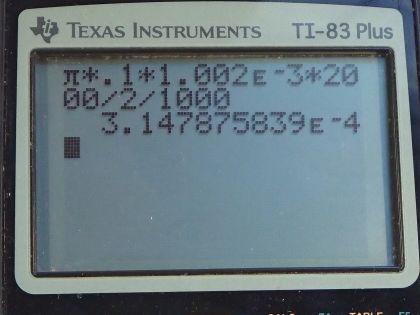Question
At what flow rate might turbulence begin to develop in a water main with a 0.200-m diameter? Assume a temperature.
Final Answer
Solution video
OpenStax College Physics, Chapter 12, Problem 56 (Problems & Exercises)

vote with a rating of
votes with an average rating of
.
Calculator Screenshots
Video Transcript
This is College Physics Answers with Shaun Dychko. We're going to calculate what flow rate, what volume flow rate is needed to maybe cause turbulence in a water main that has a diameter of 0.2 meters. And we're going to divide that by two to get the radius because our Reynold’s number formula has radius. So we're going to assume that the temperature of the water is 20 degrees Celsius. And I've written down a bunch of other things that we'll need to know as well, including this Reynold’s number has to be greater than or equal to 2000. Now, having a greater than 3000 makes us sure that there will be turbulence. But the question asks, what our flow rate would you maybe have turbulence? And so the number we're going to use then is 2000, because a random number between 2000 and 3000 might shift between turbulent and laminar flow and back to turbulent again and so on. So it might be turbulent if Reynolds number is more than 2000. So we'll need the viscosity of water at 20 degrees Celsius. And we look that up in one of our data tables ‘12.1’. It's 1.002 Milla pascals seconds. And so we got 1.002 times 10 to the minus three Pascal’s seconds. The density of water is 1000 kilograms per cubic meter. And then we look at this Reynold's number formula. It says Reynold’s number is two times the density of the fluid times its speed times the radius of the pipe divided by the viscosity of the fluid. Now, we don't know what the speed of it is, but we want to find the flow rate. So because we know the area of the tube, since it has a certain radius and has a circular cross-section. We can say that the flow rate is speed times area and solve V and then we'll be able to get rid of this V and replace it with a term with the flow rate in it. So dividing both sides by A and switching the sides around, we have V is flow rate divided by cross-sectional area of the pipe. And that is Q then divided by pi r squared. And so we substitute that in place of V. And we do that here in red. And then this r cancels with one of the rs here. And we can put all of this in the denominator of the big fraction. Or if you don't like just putting it there, you could say here's the reason we can multiply by pi r over pi r and this pi r cancels there. And then this pi r gets multiplied by the new. So we have two rho Q over pi n new and then solve this for Q by multiplying by pi times, the radius times the viscosity divided by two times the density on both sides. So the flow rate then is pi times radius times viscosity times Reynold’s number divided by two times density. That's pi times 0.100 meters radius of the pipe times 1.002 times 10 to the minus three Pascal seconds viscosity times Reynold’s number of 2000, at which point it will begin maybe being turbulent, divided by two times a thousand kilograms cubic meter. And so the flow rate should be 3.15 times 10 to the minus four cubic meters per second or more.
